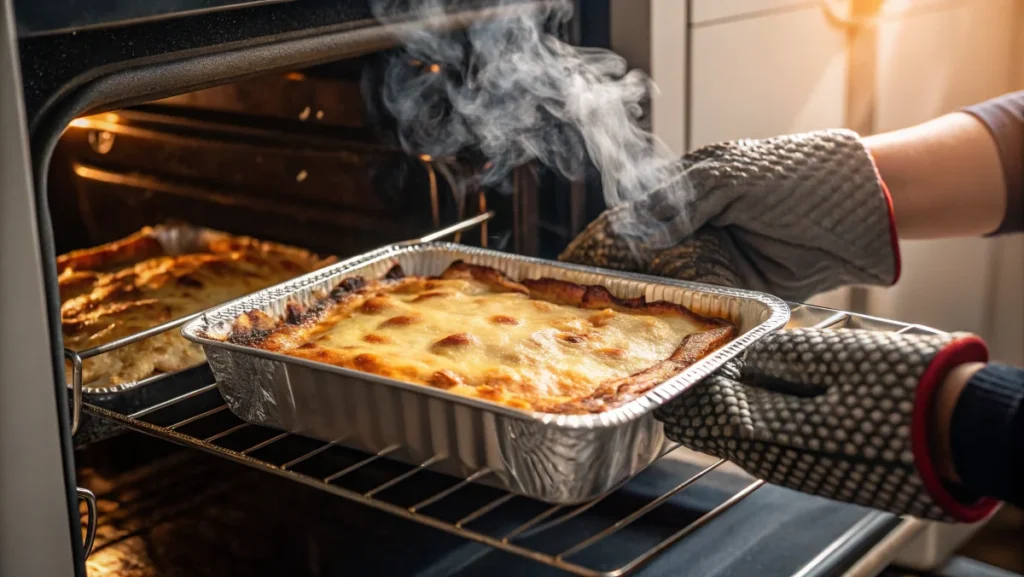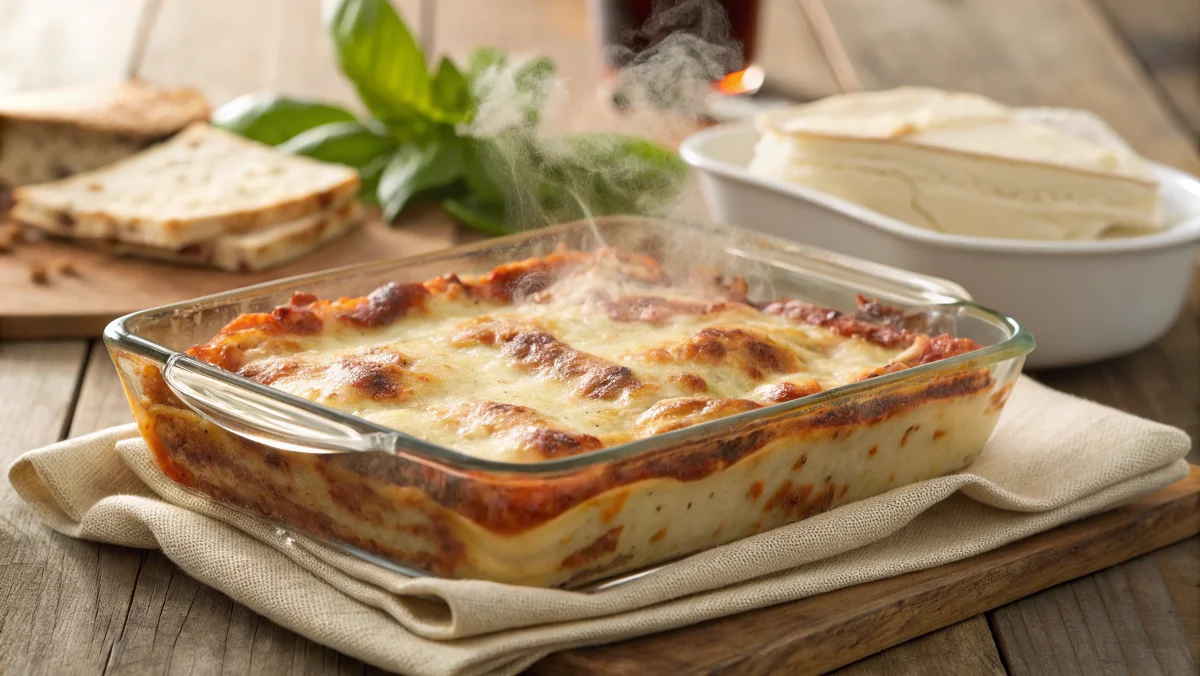Lasagna is a beloved dish enjoyed by people worldwide, but achieving the perfect texture and flavor can be challenging. Whether you are a beginner or a seasoned cook, understanding the nuances of lasagna baking can elevate your culinary skills. One common question arises repeatedly: Do you cover lasagna when baking? This decision can significantly affect the outcome of your dish. This guide delves into the essentials of lasagna baking, exploring when and why you should cover it, the science behind the technique, and tips to avoid common mistakes.
Table of Contents
Understanding the Basics of Lasagna Baking
Lasagna is a layered casserole dish made with pasta sheets, sauce, cheese, and various fillings like meat or vegetables. While the ingredients may vary, the cooking process remains consistent. Successful lasagna baking depends on a few critical factors:
- Layering: Ensure each layer is even to distribute heat uniformly.
- Moisture balance: Too much liquid can result in a soggy texture, while too little makes the dish dry.
- Oven preparation: Use a preheated oven and the correct baking dish size.
These basics lay the foundation for understanding whether to cover your lasagna during baking. The question Do you cover lasagna when baking? becomes important when considering how to retain moisture and achieve the perfect texture.
Should You Cover Lasagna When Baking?
Lasagna is a culinary classic, loved for its hearty layers of pasta, sauce, and cheese. But when it comes to baking, one common question arises: should you cover lasagna during the baking process? The answer depends on your recipe, personal preferences, and desired outcomes.
Why Cover Lasagna?
Covering lasagna during baking can have several benefits:
- Moisture Retention: Covering ensures that the lasagna remains moist throughout the cooking process, preventing the pasta from drying out.
- Even Cooking: A cover helps distribute heat more evenly, ensuring all layers cook thoroughly.
- Softer Texture: For those who prefer a tender and less crispy top, covering is a must.
Why Bake Lasagna Uncovered?
On the other hand, leaving the lasagna uncovered offers its own advantages:
- Golden, Crispy Top: Baking without a cover results in a delectable, browned cheese crust that many find irresistible.
- Reduced Moisture: An uncovered dish allows excess liquid to evaporate, which can enhance the texture of the lasagna.
Striking the Right Balance
For optimal results, many cooks recommend a hybrid approach. Start baking the lasagna covered to ensure even cooking and moisture retention, then uncover it for the final 15–20 minutes to achieve a golden-brown top. This method provides the best of both worlds.
Pro Tips for Baking Lasagna
- Use foil or a lid to cover your lasagna. If using foil, tent it slightly to avoid the cheese sticking to the cover.
- Keep an eye on the oven temperature and cooking time. Overcooking can dry out even a covered dish.
For more guidance on perfecting this Italian favorite, check out how to layer lasagna. Proper layering techniques can make a significant difference in the final dish.
The Science Behind Covering Lasagna
The baking process for lasagna involves more than just heat—it’s also about managing moisture and ensuring the even cooking of all layers. Covering lasagna traps steam, which:
- Softens pasta sheets: The trapped steam eliminates the need to pre-cook pasta sheets.
- Preserves sauce consistency: Prevents excessive evaporation that could make the sauce too thick.
- Promotes uniform heat distribution: Helps cook all layers evenly.
On the other hand, baking lasagna uncovered allows moisture to escape, which can lead to dry edges. If you’ve ever asked, Do you cover lasagna when baking?, understanding this science will clarify when covering is beneficial and how it affects the dish’s texture and flavor.
How to Properly Cover Lasagna
If you decide to cover your lasagna, doing it the right way is essential to prevent common pitfalls such as soggy layers or stuck foil.
Steps for Properly Covering Lasagna
- Use aluminum foil: It is the best option for trapping heat and moisture. Avoid plastic or other materials that can melt in the oven.
- Prevent sticking: Spray the foil with non-stick cooking spray or place parchment paper between the lasagna and foil to keep the cheese from adhering.
- Seal edges loosely: Leave a slight gap to let some steam escape, preventing overly watery layers.
- Check for bubbling: Use the cover until the sauce bubbles at the edges, ensuring even cooking.
With these steps, you can confidently answer Do you cover lasagna when baking?, knowing that proper technique ensures a delicious outcome.

Baking Times and Temperatures for Covered vs. Uncovered Lasagna
The choice to cover lasagna significantly impacts baking times and temperatures. Here’s how to adjust for each method:
Covered Lasagna
- Temperature: Bake at 375°F (190°C).
- Time: Around 30-40 minutes covered, followed by 10-15 minutes uncovered to brown the top.
Uncovered Lasagna
- Temperature: Lower the heat to 350°F (175°C) to prevent burning the top.
- Time: Bake for 45-60 minutes, depending on the thickness of layers and moisture content.
Covering lasagna initially shortens the overall cooking time, while uncovering allows the cheese to crisp. If you’ve ever wondered Do you cover lasagna when baking?, this timing breakdown offers clear guidance for both methods.
When to Remove the Cover While Baking Lasagna
Even if you begin with a covered dish, the timing of uncovering is crucial for achieving the perfect texture.
Best Times to Remove the Cover
- Golden-brown cheese: Remove the foil during the last 10-15 minutes of baking to brown the cheese.
- Crisp edges: If you prefer crispy edges, uncover slightly earlier and increase the temperature by 10-15°F.
- Prevent burning: If the cheese browns too quickly, loosely place the foil back on top.
Knowing when to uncover ensures you achieve the desired combination of a moist interior and a beautifully crisp topping. This timing helps answer the question, Do you cover lasagna when baking?, by balancing both methods.

Common Mistakes in Baking Covered Lasagna
Even with the best intentions, errors in covering lasagna can ruin an otherwise perfect dish. Here are some common mistakes and how to avoid them:
- Using improper materials: Never use plastic wrap or other non-oven-safe covers.
- Forgetting to prevent sticking: Always spray foil with non-stick spray or use parchment paper.
- Sealing too tightly: A completely sealed cover can create too much steam, leading to watery layers.
- Skipping the rest period: After baking, let the lasagna sit for 15-20 minutes to firm up and make slicing easier.
- Removing the cover too early: Exposing the lasagna too soon can dry out the top layer before the rest is fully cooked.
By avoiding these errors, you can confidently decide Do you cover lasagna when baking?, ensuring your dish turns out perfectly every time.
Mastering lasagna baking involves understanding when and how to cover it. From maintaining moisture to achieving a golden-brown top, each step in the process impacts the final result. By following these guidelines, you’ll never have to second-guess whether to cover lasagna when baking again.
Do You Cover Lasagna When Baking? A Complete Guide
Baking lasagna is an art that requires attention to detail, especially when deciding whether to cover it. The way you bake your lasagna can impact its flavor, texture, and appearance. In this guide, we’ll explore the nuances of covering lasagna during baking, alternative techniques, and expert opinions to help you make the best decision for your next dish.
Alternative Techniques to Covering Lasagna
When baking lasagna, many cooks wonder, “Do you cover lasagna when baking?” While covering is a common practice, alternative techniques can yield equally delicious results.
- No Cover Method: Bake the lasagna uncovered for the entire duration. This results in a crispy, golden top layer, but risks drying out the dish if there isn’t enough sauce.
- Partial Cover Method: Cover the lasagna for the first 20-30 minutes and then bake uncovered for the final stage. This balances moisture retention with a browned top layer.
- Using Parchment Paper: Instead of foil, cover the lasagna with parchment paper to trap moisture while allowing some airflow for even baking.
- Topping with Cheese Midway: Add shredded cheese halfway through baking. This prevents the cheese from burning while achieving a gooey finish.
Experimenting with these techniques can help you determine what works best for your preferred lasagna style.
Variations in Baking Across Different Lasagna Recipes
The question, “Do you cover lasagna when baking?” often depends on the type of lasagna you’re preparing. Different recipes require varying approaches to achieve optimal results.
Meat-Based Lasagna
Meat-based lasagna often benefits from being partially covered. The sauce’s moisture keeps the meat tender while the uncovered finish ensures a golden, cheesy top.
Vegetarian Lasagna
Vegetable fillings release water during baking, making covering essential to trap steam and cook everything evenly.
Gluten-Free Lasagna
With gluten-free noodles, it’s best to cover the lasagna to maintain moisture since these noodles can become dry or brittle.
No-Boil Noodle Lasagna
No-boil noodles need extra liquid to soften. Covering ensures the noodles absorb the sauce properly without over-drying.
By adjusting your baking technique, you can enhance the flavors and textures specific to your recipe.

Tools and Accessories for Baking Covered Lasagna
Baking lasagna successfully often involves the right tools. If you’re still asking, “Do you cover lasagna when baking?” these tools can make the process easier:
- Aluminum Foil: A staple for covering lasagna, it traps heat and moisture effectively.
- Parchment Paper: An eco-friendly alternative that prevents sticking and scorching.
- Baking Dishes with Lids: Glass or ceramic dishes with lids are perfect for seamless, even baking.
- Oven Thermometer: Ensures the oven temperature is accurate, especially when baking covered dishes.
- Foil Alternatives: Silicone baking mats or reusable covers are eco-conscious options.
Investing in the right tools will improve your lasagna baking process and make cleanup easier
Tips for Storing and Reheating Lasagna
Once your lasagna is baked, proper storage and reheating methods can preserve its quality.
Storing Tips:
- Refrigeration: Cover tightly with plastic wrap or transfer to an airtight container. Consume within 3-4 days.
- Freezing: Wrap in foil and place in a freezer-safe bag or container. Lasagna can last up to three months when frozen.
Reheating Tips:
- Oven: Preheat to 350°F, cover with foil, and bake for 20-25 minutes for even heating.
- Microwave: Use a microwave-safe cover to retain moisture and heat in short bursts to avoid drying out.
Covering during reheating ensures that the lasagna stays moist and retains its original flavors.
Nutritional Impact of Covered vs. Uncovered Lasagna
You might not realize it, but the way you bake lasagna can influence its nutritional profile. When asking, “Do you cover lasagna when baking?” consider these factors:
- Covered Lasagna: Traps steam and moisture, preserving the natural oils and juices in cheese and meats. This method helps retain nutrients while reducing the need for additional fats.
- Uncovered Lasagna: Can lead to moisture loss, causing denser textures. To compensate, you may be tempted to add more cheese or sauce, increasing calorie content.
Choosing the right method based on your health goals can make a difference in your lasagna’s overall nutrition.
Expert Opinions on Covering Lasagna While Baking
Culinary experts often weigh in on the debate: “Do you cover lasagna when baking?” Here’s what they suggest:
- Chef Tips: Covering lasagna ensures even cooking and prevents premature browning.
- Food Scientists: Covering helps maintain moisture levels, especially for recipes with delicate vegetables or no-boil noodles.
- Home Cooks: Many agree on partially covering lasagna for a perfect combination of tenderness and crispiness.
These expert insights underline the importance of covering lasagna for optimal results.
FAQs About Covering Lasagna During Baking
Is it better to bake lasagna covered or uncovered?
It depends on the stage of baking and your desired outcome. Baking lasagna covered for the first 20-30 minutes helps retain moisture and ensures even cooking, especially for recipes with no-boil noodles or delicate fillings. Uncovering it for the last 10-15 minutes allows the top to brown and the cheese to crisp up, giving the dish a golden finish. Combining both methods achieves the best balance of texture and flavor.
How long can lasagna be in the oven at 350 degrees?
Lasagna typically needs 45-60 minutes in a 350°F oven, depending on the recipe and ingredients. Cover the dish with foil for the first 30-40 minutes to keep it moist and ensure the layers cook through. Remove the foil for the final 10-15 minutes to let the top brown and the cheese bubble. Always check for doneness by inserting a knife; it should glide easily, indicating the noodles are tender.
How do I make my lasagna more solid?
To achieve a more solid lasagna, focus on a few key techniques:
- Use less liquid in your sauce to prevent sogginess.
- Allow the lasagna to rest for 10-15 minutes after baking. This helps the layers set and makes slicing easier.
- Incorporate an egg into the ricotta cheese mixture for added structure.
- Avoid overloading the dish with sauce or cheese, as too much moisture can make it sloppy.
These tips ensure a firm yet tender lasagna every time.
Do you poke holes in foil when baking a lasagna?
No, you shouldn’t poke holes in the foil when baking lasagna. Holes allow steam to escape, which can lead to drier results. The goal of covering with foil is to trap moisture, ensuring even cooking and preventing the top layer from browning too quickly. If you’re concerned about the foil sticking to the cheese, lightly spray the underside with non-stick cooking spray or use a layer of parchment paper under the foil.
Conclusion
The decision to cover or not cover lasagna while baking depends on the desired result. Covering ensures a moist, evenly cooked dish, while uncovering adds a golden, crispy top. By mastering these techniques and following our tips, you’ll create a lasagna that’s both beautiful and delicious.
For a deeper dive into the art of lasagna-making, explore our article on how to layer lasagna. With the right approach, your next lasagna will surely impress family and friends alike. Happy baking!


2 thoughts on “Do you cover lasagna when baking?”